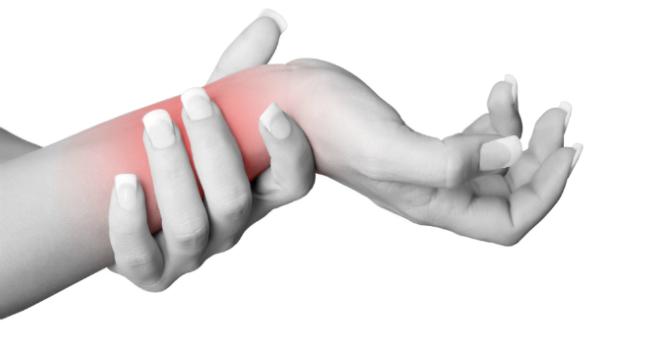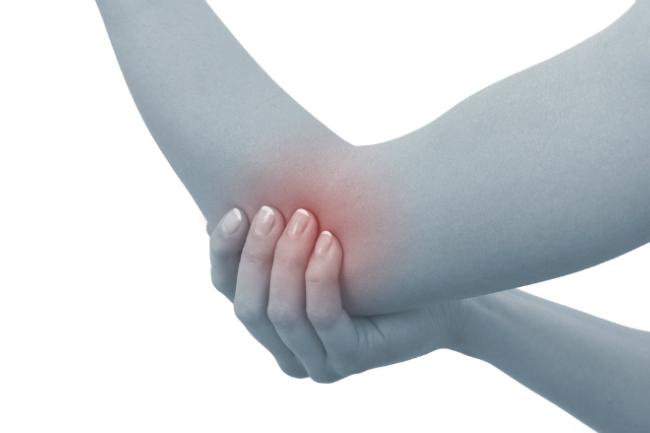Feeling the strain
Injuries caused by repetitive massage movements can end a therapist’s career. We look at what the industry can do to help
WORDS SUZANNE BRAITHWAITE
Massage training often focuses on the client perspective, from equipment to keep clients comfortable, to their enjoyment of the treatment and the massage techniques used.
However, a 60 or 90-minute massage can put a huge amount of pressure on the therapists’ wrists, fingers and thumbs, especially if they are not performing the techniques correctly. For example, having the bed too high or leaning over the client will put strain on their wrists, shoulders and lower back.
In fact, a UK study on the demographic incidence of wrist and finger damage among therapists found that 88% of massage therapists who had been giving five or more massage sessions per week for more than two years, suffered from injury.
One type of injury a therapist may experience if they perform massages day in, day out is repetitive strain injury (RSI); pain felt in muscles, nerves and tendons and caused by repetitive movement or overuse. However there are ways to prevent and treat the condition.
Access all areas
Rachel Halling, principal at Champneys College, the training arm of the UK health spa group, says her spa managers see a huge number of newly qualified therapists entering the business having already picked up bad habits. “If they are to have a prolonged career, especially when working in a busy spa, this needs addressing straight away,” she says.

When new therapists are employed at any of the Champneys resorts or day spas, group trainers carry out an initial evaluation of their massage techniques, observing therapists during induction to assess their posture and hand techniques.
They also offer guidance on improvements therapists can make, such as exercises to strengthen their legs and arm muscles, changing their stance to use body weight, and ensuring their wrist joints and thumbs are positioned at the
correct angles.
Incorrect use of equipment can also be a factor in RSI. Beata Aleksandrowicz, founder of London-based massage training school Pure Massage, advises that a simple, smaller couch is often better than the large, more complex tables. “It’s fundamental that therapists have proper access to the client’s body, without having to lean over them,” she says.
Another problem is having the table too high. “For a full-body massage, therapists should keep the table lower, so they are bending their knees and utilising their whole body. If the client is high up then a therapist will feel all the strain in their shoulders,” she says.
“There’s no way you can effectively perform a massage and give the right pressure if your body is not engaged and you are not using the right muscles. This is crucial if a therapist wants to have a long career in massage,” Aleksandrowicz, adds.
Fighting fit
“When Swedish massage was first introduced, it used to be a 15-20 minute treatment but it can now last as long as 90 minutes,” says Aleksandrowicz. “If therapists are expected to perform three massages a day, they have to be fit.” Just like an athlete, who trains to have physical endurance, she says therapists need to take better care of their bodies.
“They need to understand that their body is a tool so they should eat, sleep, and exercise as if they are in training.” She says: “I would suggest keeping their body flexible and supple. Yoga and Pilates are perfect exercises, as breathing and stretching is much better than cardio for the style of work they are maintaining.”

Aleksandrowicz also suggests that therapists turn up to work early to perform warm-up stretches (see box out on page 45) before a day of massage. It is, she adds, also important that they remember to eat regularly to fuel their day, as they are using a lot of energy.
“Some therapists need guidance from their employers about this, so spas should ensure that they have breaks when needed and suitable snacks to keep them going,” she says. While therapists should be implementing all these aspects into their lives in order to stay injury-free, Aleksandrowicz encourages them to take up these habits even if they are already suffering from RSI.
“Those with RSI or carpal tunnel syndrome first need to rest and take medication if needed. However, those that do end up taking steroids for relief often go back to the same habits, so their situation doesn’t improve,” she explains.
Pressure points
Of course, not all responsibility rests with the therapists and one step spas can take to prevent injuries among their staff is to put a cap on how many hours a day therapists can carry out massages.
Dormy House Spa in Worcestershire in the UK limits the length of therapists’ shifts to eight hours, making sure they have short breaks between massages and that they only perform a maximum of three massage in a day. Therapists also alternate between treatments, so they are not performing massages back to back.
Champneys is also mindful of preventing RSI by varying treatments on a therapist’s daily schedule and limiting the number of hours for body massage.
The company also provides regular staff workshops on maintaining good posture and alternative massage techniques, as well a providing adjustable hydraulic beds. Feedback from product houses suggests the onus is on therapists to know what they are doing, as well as on spas and salons to train their staff on how to avoid RSI.

However, Fiona Brackenbury, director of training for Decléor and Carita in the UK, feels that there should be a duty of care from the brands, too. “It is our responsibility to look after our spa and salon accounts, as well as protect their therapists,” she says.
Decléor created its Red Island wooden tool to give therapists an alternative to using fingers and thumbs. “It takes the pressure off the therapists wrists,” Brackenbury explains. “It’s moulded with a bulbous end, which is placed in the therapist’s hand and a smaller rounded end, which is great for massage on intricate areas.”
Equipment and tools such as this are a step forward, but it appears training is the key to preventing RSI and many feel the brands should be doing more. Aleksandrowicz agrees: “We have to invest in training, not just to ensure therapists are performing correctly, but also to stop the huge turnover of therapists that is still happening.”
With finding and retaining great staff already a key concern for the industry, it would certainly be a shame for massage related injuries to drive even more therapists away.
Stretching tips
Beata Aleksandrowicz shares her top five stretches to do before performing a massage:
- Stand tall and distribute bodyweight evenly under your feet. Hang arms loosely by the sides of your body. Lift your arms above you head, interlace fingers and turn palms towards the ceiling. Maintain position for 10 seconds, while lifting towards the ceiling on each out breath.
- Sit on a chair with your feet touching the floor. Give yourself a hug, with your left hand on the right shoulder and the right hand on the left shoulder. On the out breath, press your feet into the floor while lifting your spine. Then twist your torso towards your left, looking behind your left shoulder without twisting your pelvis. Hold for 10 seconds then change sides.
- Stand tall with weight evenly distributed under your feet. Put your arms behind your back and interlace fingers. Pull your hands away from the body and hold for 10 seconds.
- Stand tall with arms by your sides. Using a broad movement, make big forward circles with your shoulders, imagining the stretch is going from the middle of your chest and opening up the whole area. After five circles, repeat with a backwards circle motion.
- With arms by the sides of you body, slowly pull your shoulders towards your ears as high as possible and then vigorously drop them down. Repeat five times.

Practitioner’s view
Marcella Carnevale, massage therapist
“The techniques I have learnt from training are great for avoiding RSI. I don’t really use my fingers and thumbs, never for deep work anyway. I use my forearms and elbows instead and lean in with my body weight, so it’s far less taxing on the body.
I always try to do some swinging of my arms and wrists before a fully booked day and also do stretches to open my arms and chest. I also do the cat stretch to limber up my back and if I get the chance, I often repeat these between clients.
I work part time so I do on average two to three shifts a week, varying from five to eight hours. I only use my body in the treatments, not any other equipment.
I think the biggest thing that’s helped me loosen my body and improve my treatments is focusing on breathing deeply, which helps me relax. I also have an open stance that allows energy to flow freely, making sure to bring my attention back to my body during treatments.
My advice to other therapists is to constantly question what they are doing during treatments. Could you be doing less? Could you relax your arms and hands more? Is your back feeling relaxed and is your tailbone tucked under?’
It feels like the less I try to make something happen, the more I allow the massage to flow in an unimpeded way, which is great for my body and also feels good to the client.”

